ISSN ONLINE(2319-8753)PRINT(2347-6710)
ISSN ONLINE(2319-8753)PRINT(2347-6710)
| R.selva Bharathi, S.M.Sadham Javidur rahman, P.Rajdev, M.syed Mohamed Department of Mechanical Engineering, Sethu institute of Technology, Pulloor, Kariapatti, Virudhunagar District, Tamilnadu, india. |
| Related article at Pubmed, Scholar Google |
Visit for more related articles at International Journal of Innovative Research in Science, Engineering and Technology
The effect of various welding process parameters on the weld ability of stainless Steel specimens of grade 312 having dimensions 75mm× 55mm× 6 mm, welded by plasma arc welding were investigated. The welding current, arc voltage, welding speed, are chosen as welding parameters. The depth of penetrations were measured for each specimen after the welding operation is done on closed butt joint and the effects of welding speed, current, voltage parameters on depth of penetration were investigated. The main motivation of this project is to increase the welding depth. Next thing is to improve the welding quality and decrease the production cost of the stainless steel. But it is not improved at all sides, till now welding depth is below 3mm. So our particular aim is to improve the welding depth and also to establish the perfect method for welding in stainless steel materials
Keywords |
| Stainless steel, Plasma arc welding, weld penetration, speed |
INTRODUCTION |
| This Welding is an ancient art dating back to the Bronze Age. It produces a stable, inherently strong joint that cannot be matched with other methods. Welding skills are in high demand and engineering has become a growing job market. The plasma process is basically very similar to the TIG process but has a number of critical advantages. In plasma welding, the arc is constricted by a cooled gas nozzle. The powerfully bunched arc that results does away with the need for time-consuming weld preparation work such as V- or U-type joint preparation and for also the square cut joint. This saves as much as 30 % of the filler metal. In turn, the higher welding speed – around 20 % faster in soft-plasma welding, for example – saves time and costs at the same time as ensuring deeper penetration. Also, being enveloped in plasma gas, the tungsten electrode has a much longer service life. Here there are models for both manual and robot applications. On the manual torch, the handle- shells ergonomically shaped, making for precision torch guidance. The robot welding torch is flexibly mounted directly on the robot, in up to four positions. The tool centre point (TCP) is absolutely fixed and is the same as on TIG robot welding torches of identical construction. |
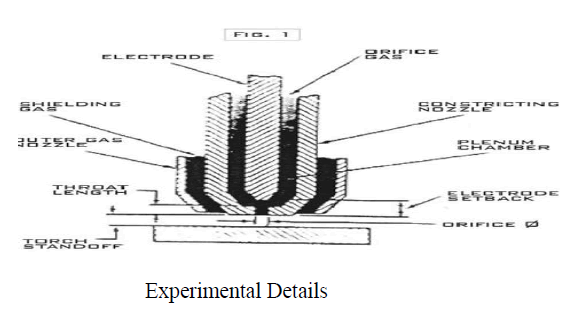 |
| A. Selection of welding parameters |
| Depth of penetration of a butt welded joint depends on a number of influencing factors like welding parameters, properties of work pieces, electrode used, welding phenomenon etc. Studies reveal that the Welding speed, Voltage, Current are the three welding parameters which influence in determining the depth of penetration of a butt welded joint and thus these three parameters are considered as design factor in the present study. In addition changing of a filler material for welding stainless steel material is also considered in the study. |
| B. Selection of welding method |
| The A literature review has been carried out which shows whether experimental or analytical, most of the studies concentrates on finding the depth of penetration of welded joint of different material for different input parameters. In this study plasma arc welding method is chosen. This is because plasma arc welding is only used for research purposes. This method has superior advantages than the traditional TIG method and so here these advantages are to be utilized. The advantages include elimination of crack in higher temperatures, absence of gas holes, complete welding for greater thickness and increased production rate. The study motivates to use the plasma arc method for commercial purposes in rural areas too. |
| C. Specimen preparation |
| The stainless steel plate is of thickness 6mm. The size of the plate comprises of length 1000 mm and breadth of 300 mm. The stainless steel material of above size has been cut into the dimensions of 80 mm length and 60 mm breadth. The cutting process is done with hydraulic machinery without any heat involvement to avoid thermal distortions. Then the material is faced at all the surfaces. So that the stainless steel pieces are of dimensions 75 mm length and 55 mm breadth. |
| The thickness of the material is maintained at 6 mm. The material is welded by plasma arc welding method. The butt joint is made without any gap between the two stainless steel plates. The stainless steel (316) filler material is used as a powder feed and argon gas as a shielding gas. After the welding process is completed the stainless steel plates are left to cool in atmospheric air. |
| D. Design of Experiment |
| In the present study welding speed (s/min), voltage (v) and current (A) are selected as design factors while other parameters have been assumed to be constant over the experimental domain Taguchi’s L25 orthogonal design have been implemented here with five levels to carry out the experiments as it allows only 25 numbers of experiments which reflects the whole process quite satisfactorily while being economic and as well as time saving. The levels are chosen on the basis of the recommendations made by the machine manufacture. In this study the welding speed, voltage, powder feed values are kept constant while the main arc current is varied. The heat applied is more than 2000° C. |
BUTT JOINT |
| A butt joint is a joinery technique in which two members are joined by simply butting them together. The butt joint is the simplest joint to make since it merely involves cutting the members to the appropriate length and butting them together. Usually, a butt-welding joint is made by gradually heating up the two weld ends with a weld plate and then joining them under a specific pressure. This process is very suitable for prefabrication and producing special fittings. Afterward, the material is usually ground down to a smooth finish and either sent on its way to the processing machine, or sold as a completed product. This type of weld is usually accomplished with an arc or MIG welder. It can also be accomplished by brazing. With arc welding, after the butt weld is complete, the weld itself needs to be struck with a hammer forge to remove slag before any subsequent welds can be applied. |
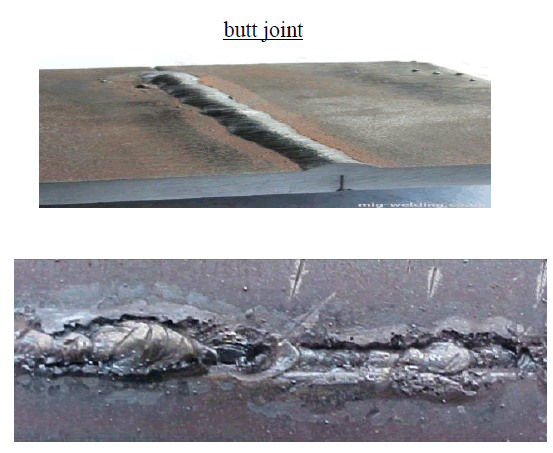 |
EXPERIMENTAL WORKING |
| The specimen is welded by plasma arc welding method. In which stainless steel 316 is used as a filler powder material. The main arc current is recorded as 100 amps, voltage as 70 v, welding speed 50 seconds, powder feed 2.0 and heat applied is 5000° c. |
| Finally, complete penetration up to 3 mm of weld occurred in the specimen in which square cut butt joint is made without any root gap present in between the parent materials. |
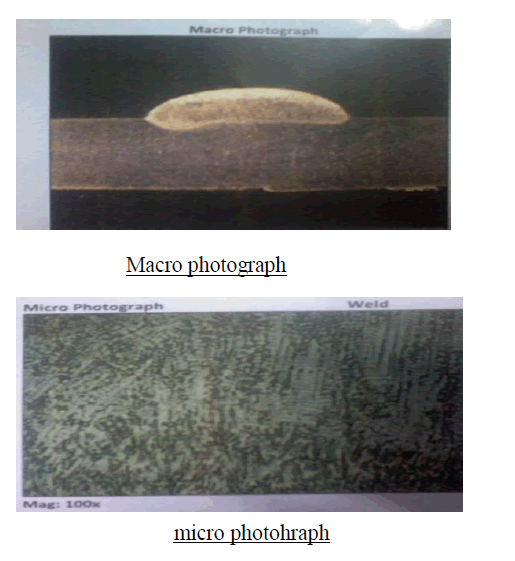 |
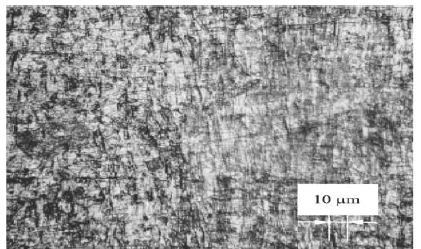 |
COMPARISON BETWEEN TIG AND PLASMA ARC WELDING |
| Plasma welding has much better penetration capabilities than TIG welding does. Because of this fact, the process is often used for seam welding components as high as 12mm in thickness; something TIG just isn’t capable of doing due to the wider arc cone. When thin components need penetration a special process called micro-plasma can be used to bring the current down as low as .5 amps. One final advantage of plasma welding over TIG welding is increased tungsten life. One of the reasons for the longer life is that a pilot arc allows starts to be more constant and reliable. |
| A. Figures and Tables |
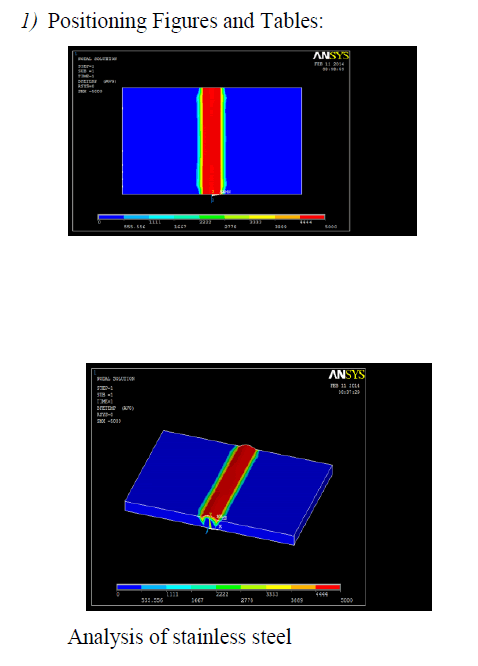 |
RESULTS & DISCUSSIONS |
| From the test results it has been observed that through plasma arc welding process the welding depth has been increased in the absence of root gap between the two specimens. The different types of materials using welding technology now a days. our project materials is 304 stainless steel but powder materials is 316 using that process. On welding the stainless steel material with 316 grade stainless steel powder filler material the welding penetration is 3mm. Due to the particular plasma arc welding process the welding defects like cracks which are eliminated to 100%, there is no lack of fusion in the welded portion and the gas holes or porosity on the weld are eliminated. This shows that the perfect welding can be done for stainless steel material through plasma arc welding process. The results are observed in Ansys software. |
References |
|